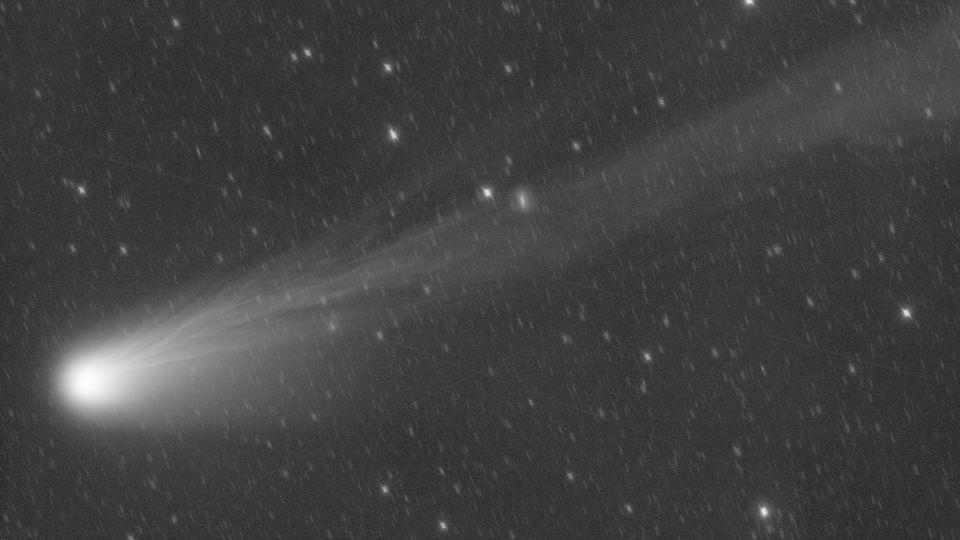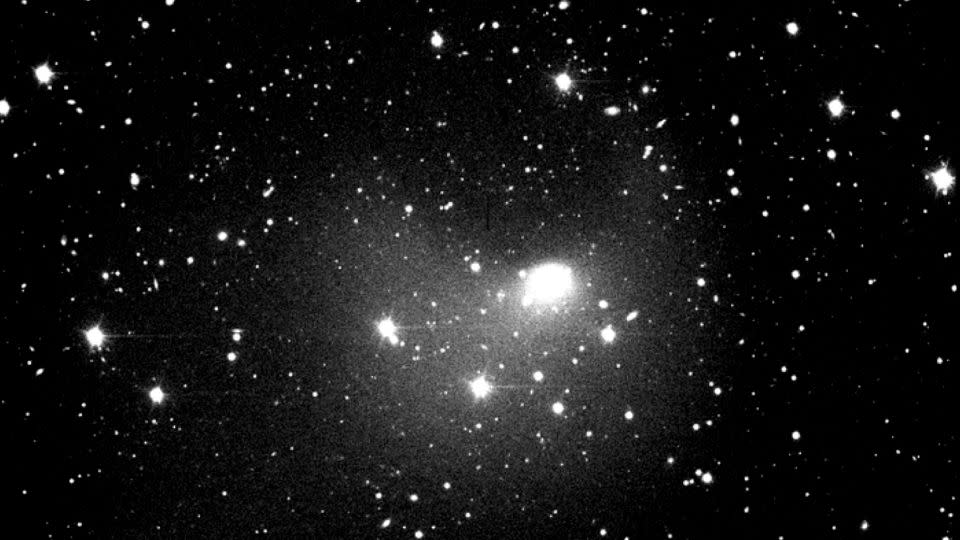Sign up for CNN’s Wonder Theory science newsletter. Explore the universe with news on fascinating discoveries, scientific advancements and more.
An unusual horned comet notable for a series of outbursts, nicknamed the “devil comet,” will make its closest approach of Earth on Sunday around 3 a.m. ET.
While the comet hasn’t been visible to those in the Northern Hemisphere since the first week of May, sky-gazers in the Southern Hemisphere have a better chance of glimpsing the fuzzy object through binoculars or a telescope.
Exactly why the dynamic comet takes on a shape that has drawn comparisons to the Millennium Falcon spacecraft from the “Star Wars” films when explosively active is still an enigma to scientists. But the celestial object only completes one orbit around the sun about every 71 years, similar to Halley’s comet, which make the odds of observing it for close study a once-in-a-lifetime opportunity.
Given that the comet won’t pass by Earth again for decades, collective observations by astronomers could provide key insights into its true nature and behavior.
Officially known as Comet 12P/Pons-Brooks, the celestial object made its closest pass of the sun on April 21, coming within 74.4 million miles (119.7 million kilometers) of our star.
The comet will make its closest pass of Earth on Sunday, but it will be more than 143 million miles (230 million kilometers) away from our planet and won’t pose a risk. For reference, the sun is 93 million miles (149 million kilometers) away from Earth.

The comet peaked in brightness in late April and has been steadily fading for three to four weeks, said Dr. Dave Schleicher, astronomer at Lowell Observatory in Arizona.
“For folks down below the equator, the coming weeks and months might be their first good chance to see this thing since the 1950s,” said astronomer Dr. Teddy Kareta, a postdoctoral associate at Lowell.
Two prolific discoverers, Jean-Louis Pons and William Robert Brooks, independently observed the devil comet — Pons in 1812 and Brooks in 1883. But the comet has likely made many trips around the sun over thousands of years, long before astronomers thought of comets as anything other than “something weird in the atmosphere,” Schleicher said.
Astronomers estimate the massive comet to be between 6.2 to 12.4 miles (10 to 20 kilometers) in diameter, Kareta said.
The rare visitor has a green appearance typical of most comets because they contain diatomic carbon molecules that absorb sunlight and emit a color that appears green from our perspective, Schleicher said.
A series of cosmic outbursts
Pons-Brooks recently captured the attention of astronomers after exhibiting intriguing behavior that caused the comet to have a horned appearance and soar through our solar system.
The comet has experienced a number of outbursts during the past eight months, causing it to eject gas and dust. While such releases are not uncommon in comets and a crescent or Pac-Man shape has been observed in other ones, it’s difficult to tell what is normal for Pons-Brooks.
“I would say it’s somewhat unusual in the number of outbursts it’s been having,” Schleicher said. “On the other hand, it’s not like you have good records from the past to really let you know what is typical. And I suspect given the fairly large number of outbursts that have happened over the last eight months, that this is very clearly a usual occurrence for Pons-Brooks.”
Comets are chunks of dust, rock and ice, essentially frozen remnants from the formation of the solar system. They also contain frozen elements such as carbon dioxide and carbon monoxide.
Comets heat up and brighten as they approach the sun, and some of the frozen gases stored in comets don’t need to warm up much before they begin to turn into vapor, Schleicher said.


“We think the ultimate driver, of course, is heating from the sun,” he said. “The comet is coming in; it’s been sitting out in a deep freeze for years. The heat is going to be working its way from the surface down to wherever that carbon dioxide or carbon monoxide ice is located.”
Astronomers suspect Pons-Brooks outbursts have occurred over the course of repeated events as heat vaporizes material inside the comet, which causes pressure to build up and break through the surface. While an explosion of gas wouldn’t be visible in telescopes, the dust it kicks up would create the kind of events observed from Pons-Brooks, Schleicher said.
Scientists have traced the jets of material observed releasing from the comet during its outburst to two source regions on its surface. Astronomers are puzzled as to why “the whole surface isn’t going off like mad,” Schleicher said.
The observations imply that ice has crusted over the majority of the surface, or the ice has been vaporized away, leaving only dirt behind, but astronomers are “not quite sure which of those mechanisms runs the show,” he said.
The comet’s outbursts seem to have ceased, however, and it hasn’t shown any outburst activity since February, Kareta said.
What we can learn from comets
Astronomers have been observing Pons-Brooks in the hopes of uncovering more details about its rotation rate, or the rate at which comets spin as they move through space. Pons-Brooks has a rotation period of 57 hours, which is longer than expected, and astronomers want to know if the jets of material releasing from the comet are speeding it up or slowing it down.
An overlapping series of events likely has contributed to Pons-Brooks’ distinctive look, but it could also be due to our perspective of the comet, Kareta said.
“These are three-dimensional objects,” Kareta said. “When we take images of the night sky, we’re taking them in a limited range of colors all flattened down in two dimensions. This will make things that might make perfect sense to you, if you’re able to go up and walk around and see it in a couple of different perspectives, look much more complicated than they really are.”
For more CNN news and newsletters create an account at CNN.com

Dr. Sarah Adams is a scientist and science communicator who makes complex topics accessible to all. Her articles explore breakthroughs in various scientific disciplines, from space exploration to cutting-edge research.








